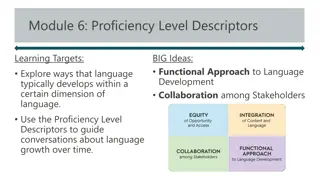On Track to English Language Proficiency: OTELP Achievement Data Insight
The On Track to English Language Proficiency (OTELP) program focuses on determining student inclusion and progress in English language proficiency. It involves analyzing data related to students' ELPA tests, performance levels, domain exemptions, and enrollment records. Key elements include tracking ELs, determining proficiency rates, and assessing student groups like English learners with disabilities or interrupted formal education. The validation process helps in aggregating data at school and district levels to monitor student progress effectively.
Download Presentation

Please find below an Image/Link to download the presentation.
The content on the website is provided AS IS for your information and personal use only. It may not be sold, licensed, or shared on other websites without obtaining consent from the author. Download presentation by click this link. If you encounter any issues during the download, it is possible that the publisher has removed the file from their server.
E N D
Presentation Transcript
On On- -Track to English Language Track to English Language Proficiency (OTELP) Proficiency (OTELP) Instructions for Achievement Data Insight (ADI) Validation
OTELP Validation OTELP Validation Detail Tab Student level data Data to determine student inclusion: Full academic year flag Year of initial ELPA test Enrolled in current ELPA test window Years identified as an EL Initial and current ELPA: Performance level by domain Proficiency determination Domain exemptions Key data elements: Include in school/district aggregations On track by domain and ELP Summary Tab Data aggregated to the student group, school, and district level Student groups: Limited English proficient (i.e., all current English learners) English learners (ELs) with disabilities ELs with interrupted formal education Key data elements: Total number of ELs (i.e., denominator) Total ELs on track to ELP (i.e., numerator) Percent of ELs on track to ELP (i.e., rate)
Detail Tab: Detail Tab: Column Definitions Column Definitions EL start date: The date a student began receiving English language development services. This comes from the Spring ESEA Title III English learner collection. EL exit date: The date a student exited from the English language development program. This comes from the Spring ESEA Title III English learner collection. Special education flag: Indicates student participation in an Individualized Education Plan (IEP/IFSP). This comes from 3rdPeriod Cumulative ADM. Interrupted Formal Education flag: Indicates whether a student has an interrupted formal education. This comes from the Spring ESEA Title III English learner collection. Enrolled in test window: Indicates whether a student has an enrollment record in 3rdPeriod Cumulative ADM during the ELPA test window. Years identified as an EL: The number of years a student has been identified as an English learner (i.e., July 1, 2019 minus the EL state date and rounded to the nearest hundredth). Included in school aggregation flag: Indicates student inclusion in school-level aggregations. Included in district aggregation flag: Indicates student inclusion in district-level aggregations. Initial domain exemption code: Code Indicating the domain exemption(s) on the initial ELPA. Current domain exemption code: Code Indicating the domain exemption(s) on the current ELPA. Domain exemption codes: A = Reading B = Reading and writing C = Reading, writing, and listening D = Reading, writing, and speaking F = Reading and listening G = Reading, listening, and speaking H = Reading and speaking J = Writing K = Writing and listening L = Writing, listening, and speaking M = Writing and speaking N = Listening P = Listening and speaking Q = Speaking The ELPA test window for accountability is truncated to account for (a) 10 days to drop enrollment in ADM and (b) 14 days to identify students as ELs (per the OCR timeline). The official test window for ELPA in 2018-19 was January 8 to April 12; however, the truncated window is January 18 to March 28.
Detail Tab: Detail Tab: Column Definitions (Cont d) Column Definitions (Cont d) Initial year: The school year associated with the student's initial ELPA (earliest year is 2015-16). Initial reading proficiency: The reading domain proficiency from the initial ELPA. Initial writing proficiency: The writing domain proficiency from the initial ELPA. Initial listening proficiency: The listening domain proficiency from the initial ELPA. Initial speaking proficiency: The speaking domain proficiency from the initial ELPA. Initial proficiency determination: The proficiency determination from the initial ELPA. Current year: The school year associated with the student's current ELPA. Current reading proficiency: The reading domain proficiency from the current ELPA. Current writing proficiency: The writing domain proficiency from the current ELPA. Current listening proficiency: The listening domain proficiency from the current ELPA. Current speaking proficiency: The speaking domain proficiency from the current ELPA. Current proficiency determination: The proficiency determination from the current ELPA. Domain proficiency: 4 and 5 = proficient Proficiency determination: 1 = emerging, 2 = progressing, and 3 = proficient
Detail Tab: Detail Tab: Column Definitions Column Definitions (additional cont.) (additional cont.) On track to reading proficiency: Indicates whether a student is on track to attain proficiency in the reading domain ( Y = yes, N = no, and D = domain exemption). On track to writing proficiency: Indicates whether a student is on track to attain proficiency in the writing domain ( Y = yes, N = no, and D = domain exemption). On track to listening proficiency: Indicates whether a student is on track to attain proficiency in the listening domain ( Y = yes, N = no, and D = domain exemption). On track to speaking proficiency: Indicates whether a student is on track to attain proficiency in the speaking domain ( Y = yes, N = no, and D = domain exemption). On track to ELP: Indicates whether a student is on track to attain ELP ( Y = yes, N = no, and Null = not included in calculations). There are a small number of ELs who have nulls for on track to domain proficiency. The null is equivalent to an N and results in an OTELP = N (unless the EL has Y for all other domains, proficiency via ELPA, or an EL exit date). The reason for the null is because the ELs had either an incorrect initial domain exemption code or an inappropriate initial testing experience (i.e., the ELs took an exempt test or did not take a nonexempt test). As it currently stands, because this occurred as part of the initial testing experience, these ELs can only reach OTELP = Y in future years if one of the following occurs: EL exit date is not null Proficient via ELPA (i.e., proficiency determination = 3) Current proficiency = level 4 or 5 on the domain with issues
Summary Tab: Summary Tab: Column Definitions Column Definitions Student Group: Limited English proficient (LEP): All current ELs (i.e., ELs in the Spring ESEA Title III English learner collection) Students with disabilities (SWD): Current ELs with a disability Student with interrupted formal education (SIFE): Current ELs with an interrupted formal education Total number of ELs: The denominator in the calculation: ELs who meet inclusion rules Total ELs on track to ELP: The numerator in the calculation: ELs who meet inclusion rules and are on track to ELP Percent of ELs on track to ELP: The rate: (Total ELs on track to ELP Total number of ELs) 100 and rounded to the nearest tenth
Current EL, first school day in May enrollment, and full academic year enrollment? Calculation: Calculation: Inclusion Rules Inclusion Rules Yes No EL exit date and/or English language proficiency via ELPA? Not Included Is the student a current English learner (EL), enrolled on the first school day in May, and enrolled for a full academic year? No Yes Included Initial ELPA test? If no, the EL is not included in OTELP calculations. This year Before this year Not included Years identified as an EL If yes and the EL has an EL exit date and/or English proficiency via ELPA, the EL is included in OTELP calculations. Less than 1.50 1.50 or more If yes and the EL does not have EL exit date and/or English proficiency via ELPA, the EL is only included if all of the following are met: EL s initial ELPA test must occur before the current year EL must be identified as an EL for 1.50 or more years EL must be enrolled during the current ELPA test window (1/18 to 3/28) Not included Enrolled during ELPA test window No Yes Not Included Included
Calculation: Calculation: Trajectory Expectations Trajectory Expectations Years Identified as an EL (No SWD or SIFE) Initial Domain Proficiency 1 2 3 4 or 5 <1.5 1.5 to <2 2 to <3 3 to <4 4 to <5 5 to <6 6 to <7 7 or more 1 2 3 2 3 3 2 3 3 3 3 3 3 4 or 5 Not Included 4 or 5 Not Included 4 or 5 Not Included 4 or 5 Years Identified as an EL (SWD and/or SIFE) Initial Domain Proficiency 1 2 3 4 or 5 There are two trajectories: 7 years for ELs who are not SIFE and/or SWD 8 years for ELs who are SIFE and/or SWD 7 growth trajectory foto <8 3 <1.5 1.5 to <2 2 to <3 3 to <4 4 to <5 5 to <6 6 to <7 8 or more 1 2 3 2 2 3 2 3 3 2 3 3 3 3 4 or 5 Not Included 4 or 5 Not Included 4 or 5 Not Included 4 or 5
Calculation: Calculation: On Track to Domain Proficiency On Track to Domain Proficiency Given initial domain proficiency and years identified as an EL: On track to domain proficiency = Y if current domain proficiency is equal to or greater than trajectory expectation. On track to domain proficiency = N if current domain proficiency is less than trajectory expectation or the EL is an ELPA nonparticipant in 2018-19. On track to proficiency for a specific domain = D if the EL with a disability has a domain exemption. On track to proficiency for a specific domain is NULL: o EL had either an incorrect initial domain exemption code or an inappropriate initial testing experience. o EL has either an EL exit date and/or English proficiency via ELPA (i.e., current proficiency determination = 3).
Calculation: Calculation: OTELP OTELP OTELP = Y: Three out of four domains have on track to domain proficiency = Y. All nonexempt domains have on track to domain proficiency = Y (if ELs have at least one domain exemption). EL has an exit date in the Spring ESEA Title III English learner collection. EL has English proficiency via ELPA (i.e., current proficiency determination = 3). Note: There are a small number of ELs who have nulls for on track to domain proficiency. The null is equivalent to an N and results in an OTELP = N (unless the EL has Y for all other domains, proficiency via ELPA, or an EL exit date). The reason for the null is because the ELs had either an incorrect initial domain exemption code or an inappropriate initial testing experience (i.e., the ELs took an exempt test or did not take a nonexempt test). As it currently stands, because this occurred as part of the initial testing experience, these ELs can only reach OTELP = Y in future years if one of the following occurs: o EL exit date is not null o Proficient via ELPA (i.e., a proficiency determination = 3) o Current proficiency = level 4 or 5 on the domain with issues























